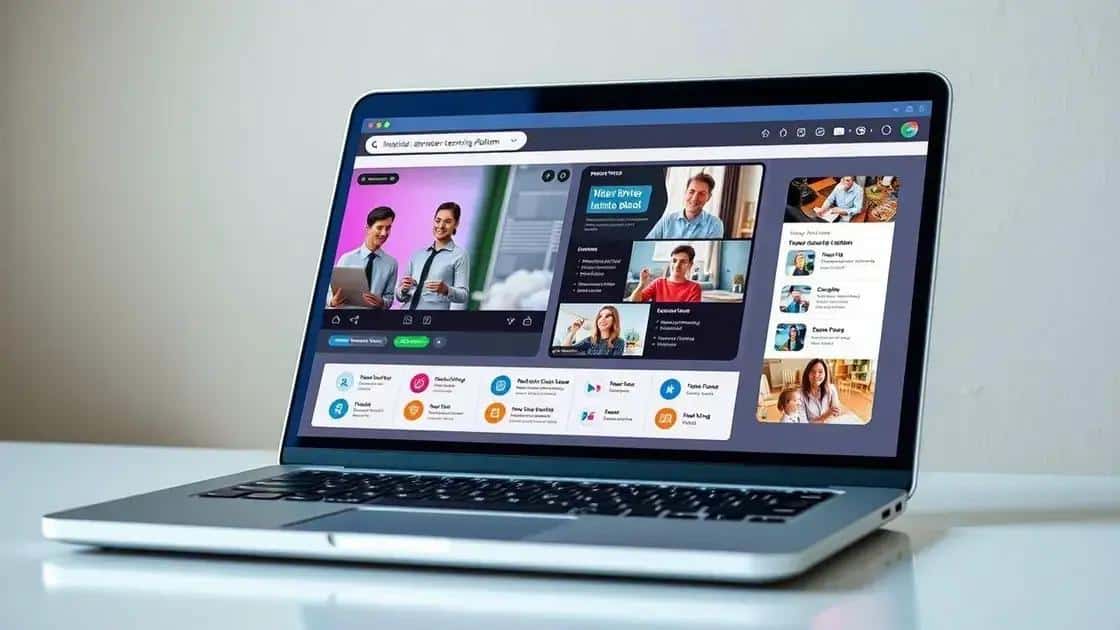Latest on remote learning platforms: what you need to know

Latest on remote learning platforms highlights advancements like AI for personalized learning, VR for immersive experiences, and gamification to boost student engagement while addressing challenges such as access, motivation, and social interaction.
Latest on remote learning platforms shows just how technology is reshaping education today. Whether you’re a student or a teacher, the evolution of these platforms impacts learning styles and educational access. Curious about what this means for you? Let’s dive in!
Understanding the benefits of remote learning platforms
Understanding the benefits of remote learning platforms is essential for both students and educators as education evolves. These platforms offer flexibility and convenience, making learning accessible from anywhere.
Key Advantages
Remote learning platforms provide a variety of benefits that can enhance the learning experience.
- Flexibility: Students can learn at their own pace, which accommodates different learning styles.
- Access to Resources: A range of multimedia resources is available, making lessons more engaging.
- Collaboration: These platforms enable collaboration among students and teachers through discussion forums and group projects.
- Cost-Effectiveness: Many remote platforms reduce costs associated with traditional education, such as commuting and materials.
Another significant advantage is the ability for students to access a variety of courses. Remote learning platforms often have a wide range of subjects available, allowing learners to choose topics that interest them the most. This encourages a more personalized educational journey.
Adaptation to Different Learning Styles
By catering to visual, auditory, and kinesthetic learners, remote learning platforms make learning more effective. For instance, videos can help visual learners grasp complex concepts, while podcasts can benefit auditory learners. This adaptability ensures that all students have the opportunity to succeed.
As we explore the benefits further, it’s clear that increased engagement is one of the core reasons these platforms are gaining popularity. Interactive quizzes and gamified learning experiences keep students motivated and interested in the material.
Real-World Application
Furthermore, remote learning platforms equip students with skills for the modern workforce. Knowing how to navigate digital tools is invaluable, as many employers seek candidates who are technologically savvy. As education continues to transform, these platforms prepare students for a fast-paced, digital world.
With all these advantages, it’s evident that understanding the benefits of remote learning platforms is crucial for anyone in the education sector. Embracing these changes can lead to enhanced educational outcomes and a more informed community.
Key features to look for in these platforms

When exploring key features to look for in remote learning platforms, it’s important to understand what makes a platform effective. A good platform should enhance the learning experience, providing tools that support both education and engagement.
Essential Features
Several critical features can significantly impact the functionality of a remote learning platform.
- User-Friendly Interface: An intuitive design makes it easier for students and teachers to navigate the platform.
- Integrated Communication Tools: Features like chat rooms and video conferencing facilitate interaction between students and educators.
- Customizable Learning Paths: Flexibility in designing curricula that can cater to individual learning needs enhances the educational experience.
- Data Security: Ensuring that student information is safe and protected builds trust in the platform.
Another important aspect is the availability of multimedia resources. A platform rich in videos, quizzes, and interactive assignments keeps students engaged. Providing diverse materials helps cater to various learning styles, which is essential for effective education.
Support and Accessibility
Moreover, robust technical support is vital. Users should have access to help whenever needed, minimizing downtime. Accessibility features such as screen readers or subtitles also ensure that all learners can engage effectively.
Flexibility in device compatibility is a feature that shouldn’t be overlooked. A platform that works well on smartphones, tablets, and computers allows learners to study anytime, anywhere, making education more accessible.
Analytics and Reporting
Lastly, analytics tools can provide insights into student performance. Features that allow educators to track progress and identify areas for improvement can enhance teaching strategies and outcomes.
When considering these key features to look for in remote learning platforms, remember that the goal is to create a supportive and effective learning environment. By focusing on these aspects, both students and teachers can have a more successful experience.
Challenges students face with remote learning
Students face various challenges with remote learning that can hinder their educational experience. Understanding these challenges is crucial for improving the effectiveness of online education.
Technological Barriers
One major challenge is access to technology. Not all students have the necessary devices, like laptops or tablets, to participate effectively. Additionally, reliable internet access is essential. Without it, students may miss out on important lessons or struggle with assignments.
- Poor Internet Connection: A slow or unreliable connection can disrupt learning and create frustration.
- Lack of Technical Skills: Some students may not be comfortable using digital tools, making it hard to adapt to remote platforms.
- Device Limitations: Older devices can have performance issues that affect the learning experience.
Another challenge is maintaining motivation. The online environment is often less structured than a physical classroom, making it easy for students to become distracted.
Emotional and Social Factors
Moreover, social interaction is limited in remote learning. Students miss the face-to-face interaction with peers and teachers, which can lead to feelings of isolation. Collaborating in person adds a dimension to learning that online platforms often lack.
Students may also experience anxiety related to their performance. With grades being assessed online, some feel additional pressure to succeed, which could affect their overall well-being. A lack of immediate feedback can exacerbate these feelings, making it difficult for students to gauge their understanding of the material.
Time Management Issues
Time management is another common issue. Without a structured schedule, some students struggle to balance their studies with other responsibilities. Creating a consistent routine is essential but can be difficult in an online setting.
The challenges students face with remote learning are multifaceted. Addressing these issues requires collaboration between educators, parents, and students to create a supportive online learning environment.
Future trends in remote learning technology

The future trends in remote learning technology are set to reshape education in exciting ways. As schools and universities adapt, several key technologies are emerging that will enhance how we learn online.
Increased Use of Artificial Intelligence
One significant trend is the integration of artificial intelligence (AI). AI can personalize the learning experience by analyzing student data to tailor lessons. This allows educators to identify individual strengths and weaknesses more effectively, optimizing learning paths for each student.
- Adaptive Learning Systems: These systems adjust content based on student progress, ensuring that no one is left behind.
- Chatbots: AI chatbots can provide instant support to students, answering questions and guiding them through challenges outside of classroom hours.
- Automated Grading: AI can help teachers by grading simple assignments quickly, allowing them to focus on more complex interactions.
Another important trend is the increased focus on virtual and augmented reality (VR and AR). These technologies provide immersive learning experiences that can make education more engaging and interactive.
Gamification in Learning
Gamification is also gaining traction. By incorporating game-like elements into lessons, students are encouraged to participate actively. This method can lead to higher engagement and motivation levels.
In addition, collaborative platforms are becoming more sophisticated. As remote learning continues, tools that promote teamwork among students are essential. This helps maintain a sense of community and connection even when learning from home.
Enhanced Data Analytics
Data analytics will also play a vital role. By analyzing how students interact with materials, teachers can fine-tune their approaches and improve outcomes. This data-driven approach enables continuous improvement in educational methods and resources.
The future trends in remote learning technology reflect a commitment to creating more effective, engaging, and personalized educational experiences. As these trends evolve, they promise to transform how students learn and interact with content.
In conclusion, remote learning has transformed the way educational content is delivered, presenting both challenges and opportunities. As we look toward the future, technology will continue to evolve, bringing new trends such as artificial intelligence, virtual reality, and gamification into classrooms. By addressing the hurdles students face and embracing these innovations, we can create a more engaging and personalized learning experience for everyone.
FAQ – Frequently Asked Questions about Remote Learning
What are the benefits of using remote learning platforms?
Remote learning platforms provide flexibility, access to a variety of resources, and the ability to learn at one’s own pace, making education more convenient.
How does artificial intelligence enhance remote learning?
Artificial intelligence tailors the learning experience to individual needs by analyzing student data and providing personalized content.
What challenges do students face with remote learning?
Students may encounter issues like lack of technology access, distractions at home, and feelings of isolation from peers.
What future trends can we expect in remote learning technology?
Future trends include increased use of VR and AR for immersive experiences, gamification for engagement, and enhanced data analytics for better teaching strategies.





